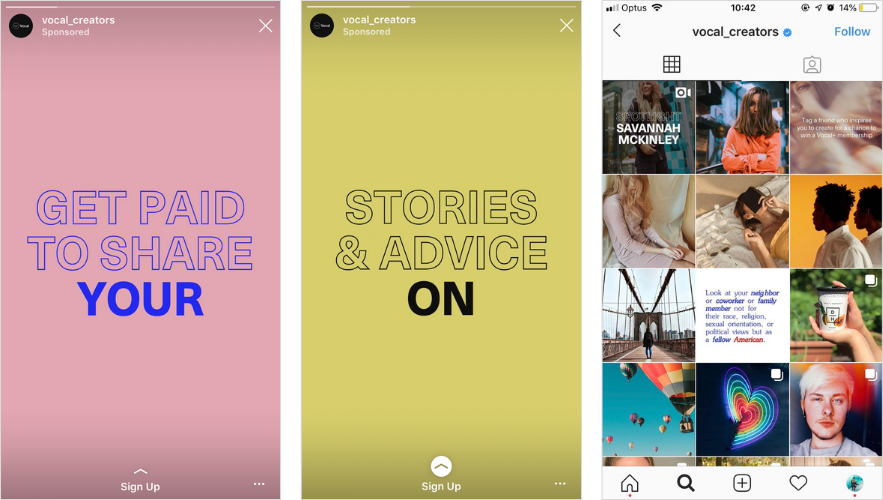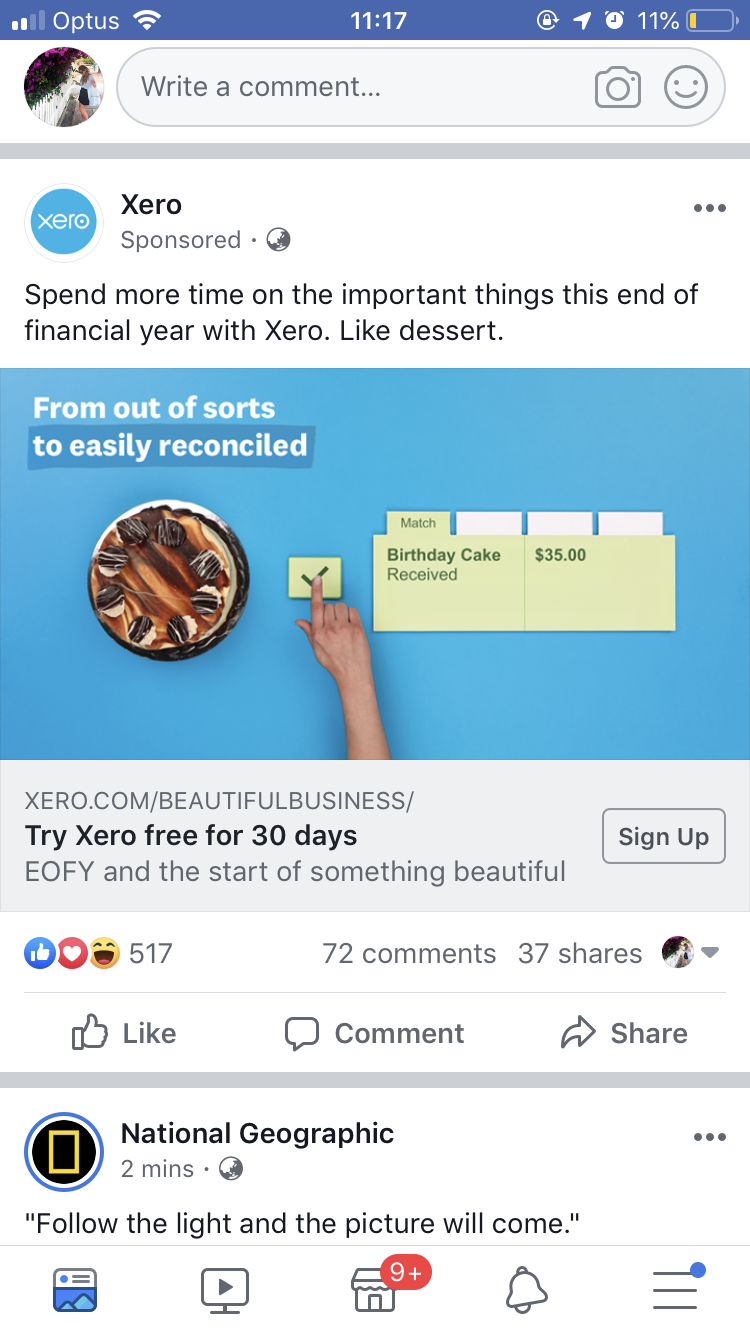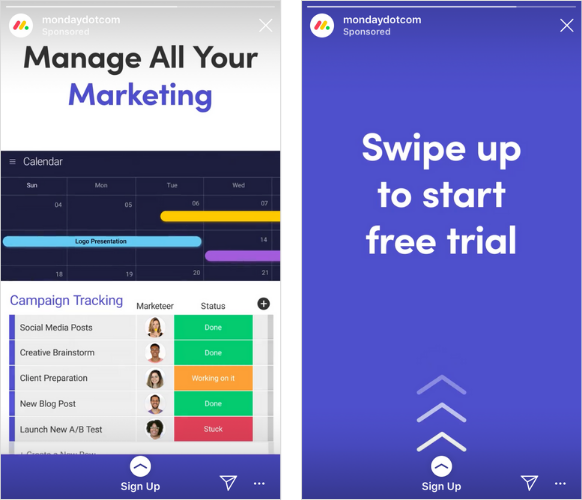Want to create social media ads that are scroll-proof and super-engaging — without tons of design work?
The good news is that you don’t need to be a Photoshop wiz or have a graphic design degree!
With some simple design and strategy tips, you can create social media ads that represent your brand, capture people’s attention, and drive real results.
We’re breaking down 7 of our top tips for making your social ads sparkle:

How to Create Social Media Ads Tip #1: Think About Your Goal
Before you sit down to create your social media ads, you need to think about your business goals and what you’re hoping to accomplish.
Are you trying to drive more viewers to your profile to get more followers? Or maybe you want to prompt a click-through to your website, or invite your viewers to shop on Instagram?

Keep in mind that different social platforms serve different audiences — your Instagram audience might have a completely different demographic to your followers on Facebook.
And for that reason, you need to consider each social media platform, along with your campaign goals, to get the ad format, design, and concept right!
Whatever your goal may be, you need to have it clear in your mind before you start designing.
For example, if your business goal is to make sales and you know your Facebook audience likes to shop online from your posts, you may want to focus your efforts on creating engaging Facebook ads.

Think about designing an ad that focuses on product shots and shows your products in action so you can convert viewers into shoppers!
On the other hand, if your goal is to promote an educational video course, you probably want to design Instagram ads around that educational content, with snippets of your course to entice viewers to click-through to learn more.
Know what you want to achieve in these early stages will really help when it comes to designing your ads!
How to Create Social Media Ads Tip #2: Decide What Ad Formats You Want to Use
If you’re just starting out in the world of social media ads, it can definitely be a little overwhelming.
Instagram alone has tons of different ad formats to choose from:

Should you create videos, Instagram Stories, or carousel ads? What about promoted posts?
To help you decide which type of ads best suit your business goal and design ideas, check out our Ultimate Guide to Instagram Advertising!
It runs through everything you need to know about creating Instagram ads, choosing the right format, and setting them up correctly to run an effective campaign.
Similarly, Facebook (as a parent to Instagram!) has plenty of ad formats to choose from including photo, video, carousel, collection, and Facebook Stories ad posts. You can find a format that best suits your campaign here.

While Twitter and Pinterest’s “Promoted” ad formats are a little basic compared to Instagram and Facebook, you can still optimize your content to best suit the platform and format!

You may also want to run ads across multiple formats and social platforms! For example, you could create an Instagram Stories ad and a Facebook video ad post to target your audiences across both platforms.
You’ll need to think about how your ad design will be different for both — it’s important not to duplicate the content in your ads!
The more unique, fun, and engaging you can make your ads the better!
Check out how Headspace has created two different ad formats for their summer campaign across Instagram (stories and posts!) and Facebook posts.

While Headspace is still sharing the same message to both its Instagram and Facebook audiences, they’ve optimized their ads to suit each platform’s format.
Happy Socks has taken it a step further — they created social media ads with individual design concepts and different formats to suit their Instagram and Facebook audience.
So while they’re still promoting their sale, having different designs and ad types gives their ads a better chance at driving shoppers from both platforms:

Now it’s time to get to work on creating engaging social media ads that convert into shoppers, followers, and loyal audience!
In the next tips, we’ll run through our top design tips and hacks using Adobe Spark to create ads that stop scrollers in their tracks:
How to Create Social Media Ads Tip #3: Work with Video for Better Conversions
If you want standout social media ads for your business, video is key.
But don’t just take our word for it — over 54% of social users prefer video posts to all other formats. Plus, social video posts generate 1200% more shares than text and image content combined!
So investing time in creating video ads for social media is definitely worth it.
A short video under the 15-second mark is the sweet spot, especially for Instagram Stories.
But within that 15-second clip, you need to make sure you have an eye-catching design that delivers a strong call-to-action, like an offer or promise.

Think about incorporating a little motion graphic or an awesome font — this can go a long way to keeping your viewers engaged and watching.
Beauty brand Glossier does a great job at showcasing their products in quick, engaging videos for their Facebook ads.
Averaging around 10-15 seconds, each ad shows the products in action — which means that even if their audience only catches a glimpse of the ad, they’ve seen how the product works, and the results:

And if you’re promoting your posts on Twitter too, video is another awesome route. After analyzing 3.7 million accounts, research found that Tweets with videos attracted 10x more engagement over Tweets without video.
Plus, a Promoted Tweet with video saved businesses more than 50% on their cost-per-engagement — which means your ad budget can stretch even further with video content!
So whether your posting Instagram, Facebook, or Twitter, having a strong video ad for your campaign really does pay off!
If you want to dip your toes into some video creating, take a look at Adobe Spark Video app.
Spark Video can help you easily compile photos, video clips, and text into a video story. No expensive software or complicated timelines here!
The built-in themes help you complete your ads with cute animations and motion, layouts, and text styling bring it life:
, we got to thinking: Is there any scientific merit to the idea of an “upside down”? Tune in to this week’s episode of Stranger Science to find out. pic.twitter.com/rcKtaXSfOW
How to Create Social Media Ads Tip #4: Use Consistent Branding in Your Ads
Even the most beautiful ad won’t deliver results if it doesn’t tie back to your brand.
Your audience needs a consistent visual presence so they can spot your brand identity while scrolling on social media!
To have a consistent visual identity, each post should look, feel, and sound like your brand. That may mean including your watermark or logo on your creative, using a set color palette, and focusing on a few fonts to deliver your message.
You also want to think about if you want your ads to match your Instagram aesthetic, so your followers will hardly notice the ad as they scroll past, just like how Moment has done it:

Or your ads could have a complimentary design creative that stands out from the rest of your feed but is still recognizable as your brand.
Check out how @Vocal_Creators achieved this with their bright neon coloring for their Instagram Stories ad campaign, but still maintained their overall look and feel with their ad posts.

If you’re still working out your brand’s visual identity, you can use Adobe Express to help ensure anything and everything you create is on-brand.
By uploading your logo, fonts, and brand colors to Spark’s brand manager, you can use the handy “brandify” button to automatically apply your brand’s style to any template in Spark’s inspiration wall!


Looking for more ways to level-up your video editing? Check out this blog post to learn how to edit your footage to match your overall brand aesthetic and style!
How to Create Social Media Ads Tip #5: Be Smart About How You Use Type
Expressive type and eye-catching designs are perfect for communicating your message efficiently and with flair.
Plus, having engaging text and fonts helps you sell without sound if you choose to use a video ad!
When it comes to Facebook, 85% of videos are watched without sound. And we’d hedge a bet that Instagram videos follow a similar pattern, so you want to make sure you can get your message across even if the volume is switched off.

The good news is that you don’t need to have a graphic design background to make something that looks great.
A good place to start is with your own branded font. Not only will this help you with improving your brand awareness but it will also help to maintain your Instagram aesthetic.
Or if you’re looking to revamp and find new fonts for your brand, take a look at Google Fonts — with over 900 free to use fonts to choose from, you can start experimenting with some great looking fonts that compliment your brand.
If you’re overwhelmed looking at all the font options (not to mention coming up with a font pairing!) take a look at Adobe Express’ templates, which build in winning pairings for you, as well as let you customize with thousands of fonts from the world’s leading type foundries
Their ready-to-edit templates have built-in cool fonts, images, and engaging layouts to get you rolling. From here, all you have to do is swap in your own images or access the high-quality images from Spark’s free stock photo library and change-up the copy.
Here are some sample premium templates from Adobe Express to get you inspired:

How to Create Social Media Ads Tip #6: Include a Call-to-Action
A strong ad is one that uses a strong call-to-action.
And we don’t just mean in the ad design — you need to think about your social ad post caption too!

That’s not to say that general lifestyle posts don’t add value to your brand or don’t have an important place in your customers’ feeds.
But if you’re trying to convey a message about a special sale, launch, or event in your ad, you need to have a call-to-action to let customers know why they should care, and what they should do about it!
You might want people to visit your profile, swipe up to land on your site, or something else entirely. But whatever action you’d like to evoke from your audience, make sure you’ve highlighted it in your creative!
Your text and font might do some of the heavy-lifting when it comes to your call-to-action, just like Monday:

And don’t forget that you can add in fun elements like GIFs, sparkles, or arrows to help direct your viewer’s eyes to where they should be clicking or swiping!
How to Create Social Media Ads Tip #7: Get Your Sizing Right
For maximum wow-factor, create content that’s perfectly sized for the type of social media ad you’re planning to post on.
If you really want to get results from your ads, we don’t recommend using the same dimensions for each ad type — for example, your Instagram Stories ad design dimensions need to be different to your video post ad dimensions.
It’s all about optimizing each ad so you can get the best performance and results!
Not sure what dimensions to use where? Don’t worry — we have you covered with a great infographic in our Ultimate Guide to Instagram Advertising!
For simple, one-click resizing, we love using the Spark Post App to quickly resize any video or image size to the right dimensions for your ads!

One of the best perks with Spark Post app is that it also saves all your posts and allows them to be duplicated and edited.
This means you can duplicate content and resize it for different channels, making it super easy to spread the news about anything from an upcoming sale to a product release.
When it comes to creating social media ads, the foundations are built with your business goals.
But if you want to drive results, you need to start strategically thinking about your design and using all the tools, assets, and apps at hand to help you create social media ads that convert!
Feel ready to grow your business and following on social media? Sign up to Later today and start planning, scheduling, and strategizing for all your social platforms in one place! P.S — it’s free!


